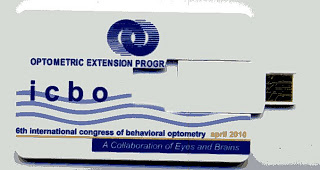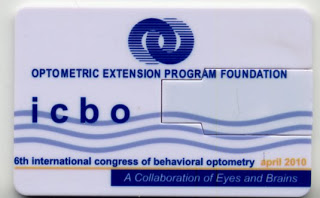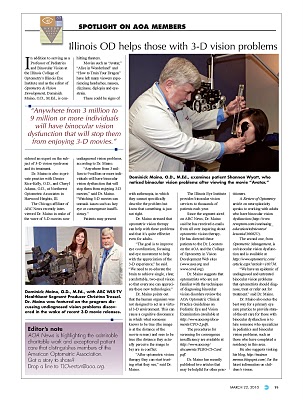...In adults, the FFP provides accurate measurements of HRs that are in excellent agreement with measurements by FBP. In infants, measurements of HRs by the FFP show the same repeatability and consistency as in adults....
Comments: My students always confuse Hirschberg and Kappa...perhaps this will help! DM
MainosMemos contains the latest research and information about eye and vision care of children, developmental disabilities, Traumatic/Acquired Brain Injury and other topics of interest to me (and hopefully you!).
Saturday, April 17, 2010
Pattern visual evoked potentials in the assessment of objective visual acuity in amblyopic children
...The aim of this study was to determine the value of pattern visual evoked potentials (PVEP) to five consecutive check size patterns in the assessment of visual acuity (VA) in children. One hundred unilateral amblyopic (study group) and 90 healthy children with best-corrected visual acuity (BCVA) of 1.0 (control group) were planned to be included. ... Snellen acuity was well correlated with the logMAR PVEP-VA (r = 0.525, P < 0.001) in the study group. The Snellen line discrepancy between BCVA and PVEP-VA was within ±1 Snellen line in 57.6% of the eyes. PVEP to five consecutive check sizes may predict objective VA in amblyopic children. ...
Sports Vision: An Interview with Dr. Arnold Sherman
...
Sports Vision: An Interview with Dr. Arnold Sherman
April 14, 2010 by Dr. Rochelle Mozlin
Part 2 — Hockey
Dr. M: Let’s talk about hockey. I know that is one of your favorite sports and that you actually worked with the 1980 gold medal Olympic Team.
Dr. S: Yes, I had the pleasure of actually evaluating potential members of that team. That evaluation was one additional piece of information used by Herb Brooks in selecting the players for the Olympic Team.
Dr. M: So you should have gotten a gold medal too!
Dr. S: At least I can say I had a small part in winning the gold medal.
Dr. M: Let’s start with the goalie....
Comments: Read the whole interview by clicking on the title above. DM
Sports Vision: An Interview with Dr. Arnold Sherman
April 14, 2010 by Dr. Rochelle Mozlin
Part 2 — Hockey
Dr. M: Let’s talk about hockey. I know that is one of your favorite sports and that you actually worked with the 1980 gold medal Olympic Team.
Dr. S: Yes, I had the pleasure of actually evaluating potential members of that team. That evaluation was one additional piece of information used by Herb Brooks in selecting the players for the Olympic Team.
Dr. M: So you should have gotten a gold medal too!
Dr. S: At least I can say I had a small part in winning the gold medal.
Dr. M: Let’s start with the goalie....
Comments: Read the whole interview by clicking on the title above. DM
Acquired Glaucoma Predominates in Children
...Acquired forms of glaucoma account for almost two-thirds of cases involving children, according to findings from the first reported epidemiologic study of pediatric glaucoma in the U.S....A single case of primary congenital glaucoma at birth was diagnosed during 40 years of follow-up, resulting in a rate that was lower than those from studies in other countries....The overall incidence of childhood glaucoma was 2.29 cases per 100,000 residents younger than 20, investigators reported...
Rare Gene Variants Linked to High Risk of Broad Range of Seizure Disorders
....scientists...found that 23 of the patients with epilepsy had deletions on chromosome 16 at 16p13.11, but no such deletions appeared in the DNA of the healthy volunteers. They also discovered that the deletion included seven genes and that at least one of the two copies of each of these genes had been shut down in the affected patients. "That means that the amount of protein normally produced by these genes is likely reduced in these patients.......
Dramatic Increase in Infant Syphilis Cases
....Congenital syphilis cases jumped 23% from 2005 to 2008 (8.2 to 10.1 cases per 100,000 live births), found J.R. Su, MD, of the CDC's National Center for HIV, Hepatitis, STD, and TB Prevention in Atlanta, and colleagues.
The reason appeared to be a 38% increase in the rate of primary and secondary syphilis among women ages 10 and older from 2004 to 2007, they wrote in the April 16 issue of Morbidity and Mortality Weekly Report.....
Comments: Children with syphilis can have many eye problems. DM
The reason appeared to be a 38% increase in the rate of primary and secondary syphilis among women ages 10 and older from 2004 to 2007, they wrote in the April 16 issue of Morbidity and Mortality Weekly Report.....
Comments: Children with syphilis can have many eye problems. DM
Thursday, April 15, 2010
3-D Movies may not be so "D"- lightful!
Wednesday, April 14, 2010
International Congress of Behavioral Optometry/Neuro-Optometric Rehabilitation Association 2010


At the International Congress of Behavioral Optometry/Neuro-Optometric Rehabilitation Association 2010 meeting those organizing the meeting did something very unique. They gave those attending an opportunity to choose a binder with the paper handouts, a CD of the handouts or a cool USB card...with the handouts. I chose the USB card. This is a great way to save paper AND it is also a wonderful PR tool for ICBO/NORA. I will use this USB card often....and when I do ICBO/NORA will be on my mind!
Unconscious Learning Uses Old Parts Of The Brain
...A new study ... provides evidence that basic human learning systems use areas of the brain that also exist in the most primitive vertebrates, such as certain fish, reptiles and amphibians. The study involved an investigation into the limbic striatum, one of the evolutionarily oldest parts of the brain, and the ability to learn movements, consciously and unconsciously, through repetition...."Our results strongly substantiate the theories that say that the implicit, by which I mean non-conscious, learning systems of the brain are simpler and evolutionarily older," ...
By 20 Years Of Age 90 Percent Of Children With Intermittent Exotropia Will Become Nearsighted
...Intermittent exotropia, a condition in which the eyes turn outward while looking at an object, occurs in about 1% of American children and is less common than esotropia, where the eyes turn inward. .... researchers ... followed 135 patients with intermittent exotropia over a 20-year period and found that slightly more than 90% of these children became nearsighted by the time they reached their 20s. ...
Comments: Another good reason to have your children examined early (between 6-12 mos of age...see info on InfantSee) and once a year while in school. DM
Comments: Another good reason to have your children examined early (between 6-12 mos of age...see info on InfantSee) and once a year while in school. DM
Music Therapy Fails Dyslexic Readers
...There is no link between a lack of musical ability and dyslexia. ... attempts to treat dyslexia with music therapy are unwarranted, according to scientists in Belgium writing in the current issue of the International of Journal of Arts and Technology....Cognitive neuroscientist José Morais of the Free University of Brussels and colleagues point out that research into dyslexia has pointed to a problem with how the brain processes sounds and how dyslexic readers manipulate the sounds from which words are composed, the phonemes, consciously and intentionally. It was a relatively short step between the notion that dyslexia is an issue of phonological processing and how this might also be associated with poor musical skills amusia - that has led to approaches to treating the condition using therapy to improve a dyslexic reader's musical skills....
Comments: When are these scientists going to get it that reading is more than sounds and phonemes... Vision plays a role here...take a look at that as well. Perhaps, learning music also has a visual component just like reading? DM
Comments: When are these scientists going to get it that reading is more than sounds and phonemes... Vision plays a role here...take a look at that as well. Perhaps, learning music also has a visual component just like reading? DM
http://www.medicalnewstoday.com/articles/184630.php
...Results of a randomized clinical trial found an innovative multi-component summer social development program to be effective in improving the social performance of children with high-functioning autism spectrum disorders....
Emotion Recognition Improved By Oxytocin
...Autism spectrum disorders (ASD) are developmental disorders usually diagnosed in childhood. Children with ASDs have impairments in social interactions and communication, and a tendency towards repetitive behaviors. A hallmark of autism is a difficulty in understanding and reciprocating the emotion of others. ....Oxytocin is a hormone that has effects on brain function. .... is also important in promoting trust, love, and social recognition....the subjects' performance on the task [understanding and reciprocating the emotion of others] was improved when they received the oxytocin spray....
Early Vision Intervention Affirmed for Some Preemies
...Overall, treating babies at high risk of progression to retinopathy of prematurity did not reduce their risk of poor visual acuity at age 6 years compared with conventional cautious observation with treatment only after children reached the threshold for disease (24.6% versus 29.0%, P=0.15), ....But early treatment of those with "type 1 eyes" marked by dilation and tortuosity of retinal blood vessels in at least two quadrants of zone I or II or stage III disease in zone I did reduce their risk of 20/200 or worse visual acuity at age 6 (25.1% versus 32.8%; P=0.02), ....
Maino D, Schlange D, Donati R. Bakouris C, Nikoniuk M. A Gun Shot to the Head: Oculo-visual & Perceptual Anomalies. International Congress of Behavioral Optometry/Neuro-Optometric Rehabilitation Association 2010. Ontario, CA 4/10
Check out this SlideShare Presentation:
Maino et al gun shot pdf 04 05-10
View more presentations from Dominick Maino.
Monday, April 12, 2010
Illinois OD helps those with 3-D vision problems

The American Optometric Association News (AOANews)noted that Illinois OD helps those with 3-D vision problems.
The AOA was kind enough to use some of my activities to highlight the need for comprehensive eye examinatons that include the assessment of the binocular vision system. The story quoted me frequently noting that:“Anywhere from 3 million to 9 million or more individuals will have binocular vision dysfunction that will stop them from enjoying 3-D movies,” said Dr. Maino. “Watching 3-D movies can unmask issues such as lazy eye or convergence insufficiency.”
This story continued:
Dr. Maino stressed that optometric vision therapy can help with these problems and that it’s quite effective even for adults. The goal is to improve eye coordination, focusing and eye movement to help with the appreciation of the 3-D experience,” he said.
“We need to re-educate the brain to achieve single, clear, comfortable, two-eyed vision so that everyone can appreciate these new technologies.”
Dr. Maino points out that the human organism was not designed to act in a virtual 3-D environment. This can cause a cognitive dissonance in which what someone knows to be true (the image is at the distance of the movie screen) and sees to be true (the distance they actually perceive the image to be) are in conflict.
If you are an optometrist and are interested in diagnosing and treating these disorders please see Neuroplasticity: Teaching an Old Brain New Tricks and Identify Binocular Vision Disorders
Subscribe to:
Posts (Atom)

